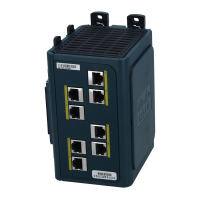35
Troubleshooting
Resetting the Switch
Switch Performance
Speed, Duplex, and Autonegotiation
Port statistics that show a large amount of alignment errors, frame check sequence (FCS), or late-collisions errors, might
mean a speed or duplex mismatch.
A common issue occurs when duplex and speed settings are mismatched between two switches, between a switch and
a router, or between the switch and a workstation or server. Mismatches can happen when manually setting the speed
and duplex or from autonegotiation issues between the two devices.
To maximize switch performance and to ensure a link, follow one of these guidelines when changing the duplex or the
speed settings.
Let both ports autonegotiate both speed and duplex.
Manually set the speed and duplex parameters for the interfaces on both ends of the connection.
If a remote device does not autonegotiate, use the same duplex settings on the two ports. The speed parameter
adjusts itself even if the connected port does not autonegotiate.
Autonegotiation and Network Interface Cards
Problems sometimes occur between the switch and third-party network interface cards (NICs). By default, the switch
ports and interfaces autonegotiate. Laptops or other devices are commonly set to autonegotiate, yet sometimes issues
occur.
To troubleshoot autonegotiation problems, try manually setting both sides of the connection. If this does not solve the
problem, there could be a problem with the firmware or software on the NIC. You can resolve this by upgrading the NIC
driver to the latest version.
Cabling Distance
If the port statistics show excessive FCS, late-collision, or alignment errors, verify that the cable distance from the switch
to the connected device meets the recommended guidelines. See Cables and Adapters, page 38.
Resetting the Switch
These are reasons why you might want to reset the switch to the factory default settings:
You installed the switch in your network and cannot connect to it because you assigned the wrong IP address.
You want to reset the password on the switch.
Note: Resetting the switch deletes the configuration and reboots the switch.
To reset the switch:
1. Press and hold the Express Setup button (recessed behind a small hole in the faceplate) for about 15-20 seconds
with a paper clip or similar object. The switch reboots. The system LED turns green after the switch completes
rebooting.
2. Press the Express Setup button again for 3 seconds. Fa 1/1port blinks green.
The switch now behaves like an unconfigured switch.
